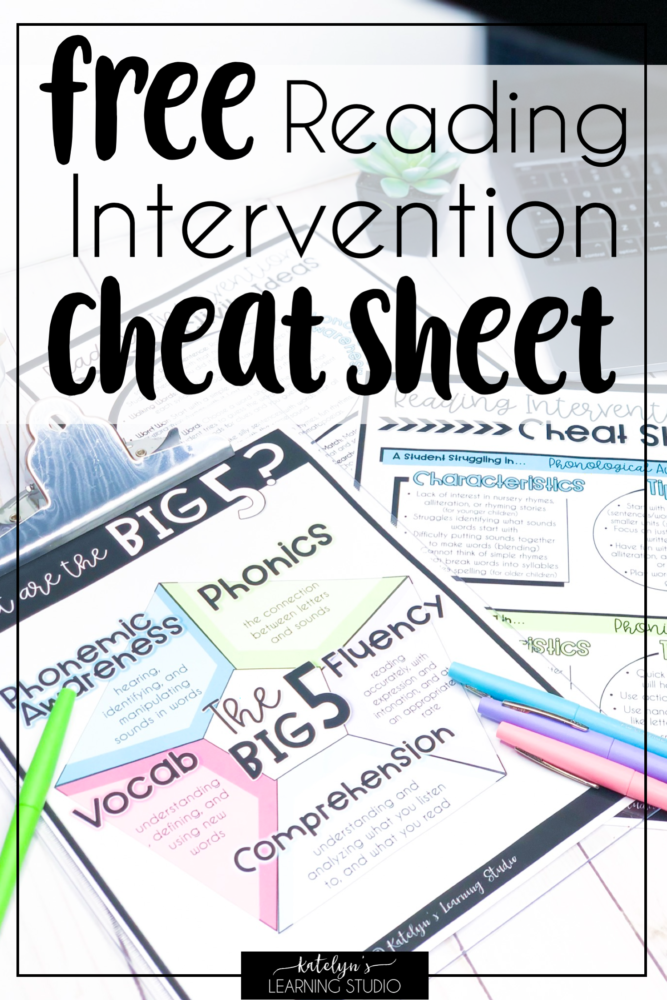
Check out this huge list of fun reading intervention activities to try out with your struggling readers.
Reading Intervention Activities and
Ideas for Struggling Readers
You’ve hit the gold mine! This is the jackpot of reading intervention activities and I’m so excited to share all of my favorites with you!
Below is a HUGE list of reading intervention activities you can do with your struggling readers that target all of the different learning styles.
Reading intervention is my passion. There is nothing more exciting than seeing a struggling reader learn how to read. After countless reading intervention activities, programs, small group lessons, and data tracking– seeing it all pay off. When the light bulb clicks and you see their faces light up with confidence.
We want ALL of our students to succeed. We find joy when our high kiddos succeed. But we spend sleepless nights worrying about those students who are falling behind. It can be so hard knowing what our students need and how to help them. If you’re feeling stressed out, please go read my post on The Key to Stress Free Reading Intervention and hopefully that can help you a bit!
Once you’re feeling good about reading intervention, then go check out this post for 11 Effective Reading Intervention Strategies you can implement now. Below are some specific multi sensory learning and reading intervention activities that I have found helpful in reaching my lowest sweet readers.
Side Note: Reading Intervention Helps
Just a quick note, if you need some extra direction for your reading intervention, I have a FREE Reading Intervention Cheat Sheet you can download here. It has student characteristics, tips, and activities specific to each area of reading. Seriously a lifesaver! I also have a Reading Intervention Assessment that will help identify exactly which skills each of your students need intervention in, which you can check out too.

Students usually learn in one of 4 ways: Auditory, Tactile, Kinesthetic, or Visual.
Multisensory Learning in Reading Intervention
Studies have shown that learning is more likely to stick when engaging multiple senses at the same time. The more senses activated, the better! This list of activities takes a multi sensory approach to learning and focuses on pulling in all of the different learning styles.
What are the 4 Main Learning Styles?
All students learn differently, and struggling readers most likely won’t respond to normal teaching methods. So I’ve organized this list of reading intervention activities by learning type. All of these reading intervention activities can be just out of the ordinary enough to engage any student. However, you can find surveys online to give students like this one or this one to help figure out what kind of learner they are.
The 4 Main Learning Styles:
- Tactile learners (respond well to hands-on activities that involve touching and manipulatives)
- Visual learners (respond well to visual cues and prompts they can see)
- Auditory learners (respond well to listening, hearing, and talking about concepts)
- Kinesthetic (respond well to movement and interaction)
Students can have any combination of the above learning styles–there is no hard-set rule for categorizing different learners. However, students will often lean towards one or two learning styles and it’s great to capitalize on what they enjoy and respond to best.
Again, even if your student does not fall neatly into any of these categories, all of these activities are engaging enough to appeal to most students. We are all really “multisensory learners!”
Reading Intervention Activities for Tactile Learners:
These reading intervention activities are great for those students that like to use their hands and feel as they learn. They are especially great for younger readers, but they can still work for all ages.

Hands-on reading intervention activities you can use for tactile learners.
1. Making Words with Letter Tiles
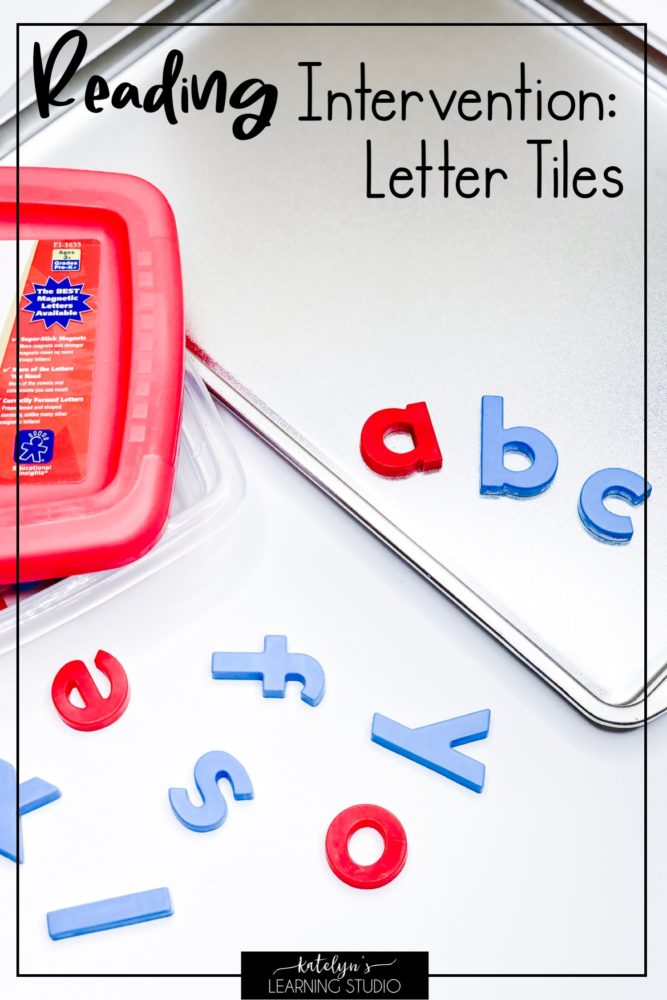
Use magnetic letter tiles for a fun reading intervention activity.
This is one of my go-to reading intervention activities. Use magnetic letters like these and place them on mini cookie sheets (I found my cookie sheets at Walmart). A set like this is also good for a class set.
- Make a CVC word together
- Then discover other words in the same word family by swapping out the first letter
- Try swapping out the last letter and the vowel
- Compare how the words sound as you change one letter
**I would just focus on switching ONE letter position at a time (the first, middle OR last letter) for each lesson, not all three at once.
2. Touch Reading
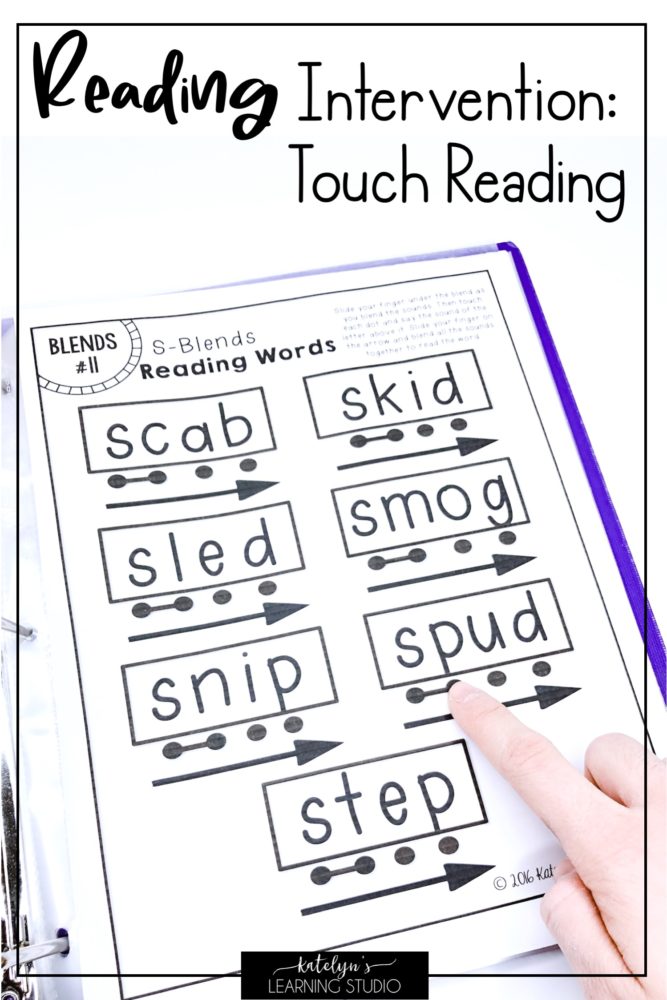
Check out these Reading Intervention Binders that have touch activities to practice skills.
Give students something to touch while sounding out words or reading sentences. This can be a dot, blank square, line, etc. As they first begin to read, one-to-one correspondence is so important–both with each letter as they sound out words, and each word as they read sentences. Try some of the touch-intervention activities included in my CVC Intervention Binder, Phonics Intervention Binder, or Fluency Intervention Binder.
3. Play Dough

Here are some ideas for using play-dough as a fun, hands-on reading intervention activity.
I have a whole blog post about using play-dough to teach phonics! Play-dough is such a fun way for students to learn hands-on! This is definitely a student favorite reading intervention activity.
4. Arm Slide

Use arm slides as a reading intervention activity for blending sounds.
This is one of my favorite, simple reading intervention activities! I use it at the beginning of the year when we are working on blending words together.
Arm Slide Blending Activity:
- Start with your left arm held out in front of you, like a slide.
- Then use your right hand to pat down your shoulder as you say each sound.
- When you say all the sounds, go back up to your shoulder and slide your hand down the slide as you say the whole world.
You can see a video of this in my Instagram “Teaching” story highlights.
5. Sensory Association
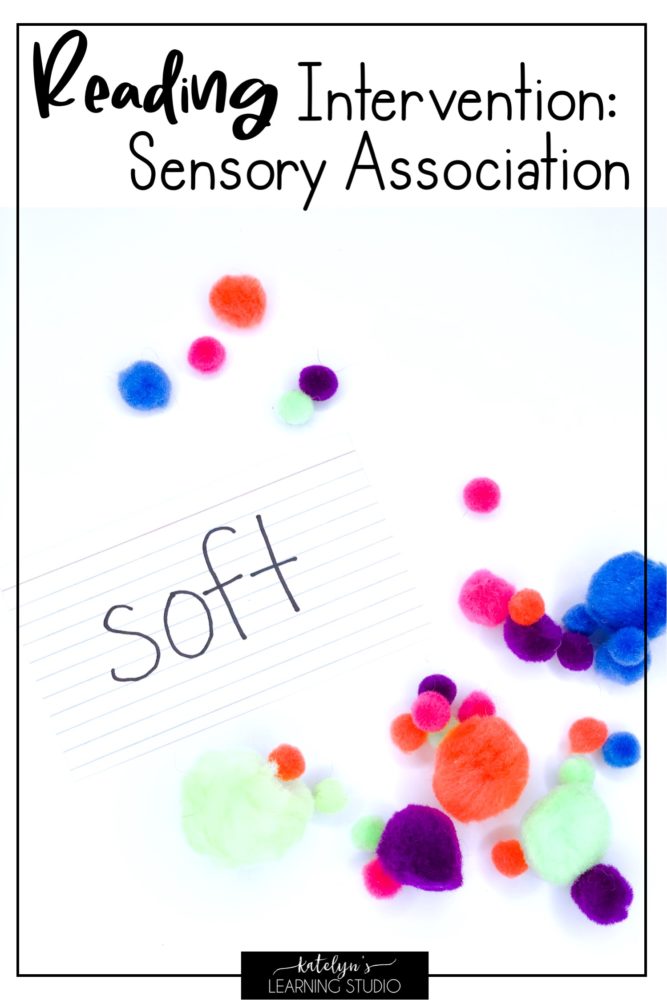
Sensory association can be a great reading intervention activity to learn spelling and sight words.
- For the word “pin”, I had each student hold up their finger, and gently brushed each finger with the tip of the pin.
- Next, for the word “chin” I had them gently touch their neighbor’s chin.
- Then, for the word “grin”, I had them push the corners of their mouth up into the biggest grin they could make.
Obviously, some words are easier than others, but get creative! You can get really good (and silly!) at making sensory associations.
Reading Intervention Activities for Visual Learners:
These reading intervention activities work well for students who like to see and get a good visual picture of what they are learning.
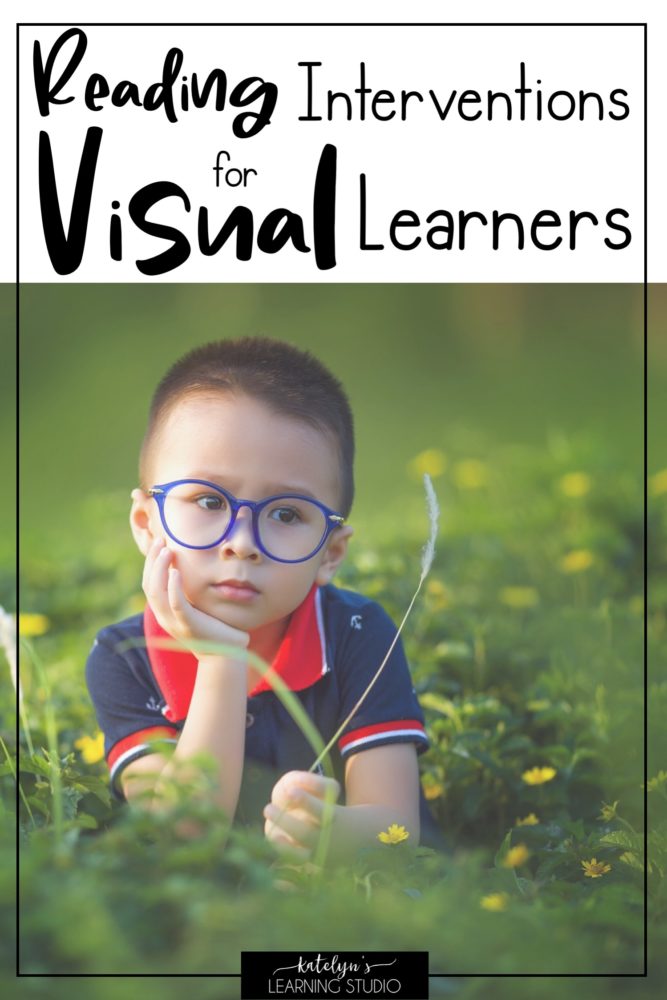
Reading intervention activities to use with your struggling students who are visual learners.
6. Color Code
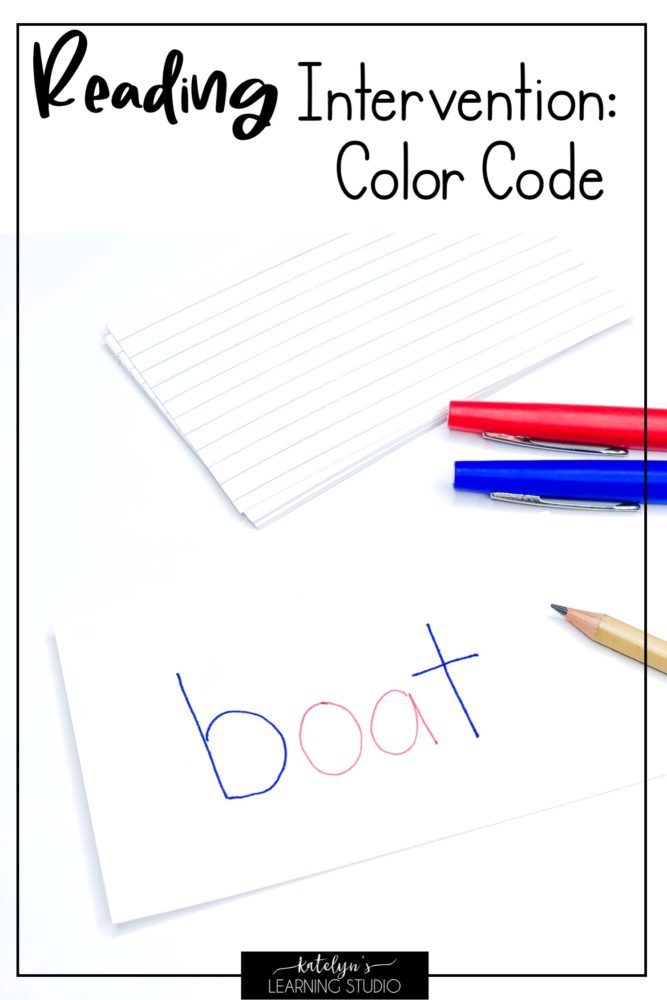
Use color codes for visual learners.
Color coding reading intervention activities work great for specific phonics patterns.
- Assign a color to different parts of the word.
- You could use blue for consonants and red for vowels, pink for a phonics pattern and purple for the rest of the word, green for the base word and yellow for the ending, etc.
- I like to have the part we are focusing on be in a color that stands out more.
- Use whiteboards with dry-erase markers for extra engagement!
Here’s a post that explains how to teach phonics patterns, and this strategy works great with it!
7. Mark-Up Words
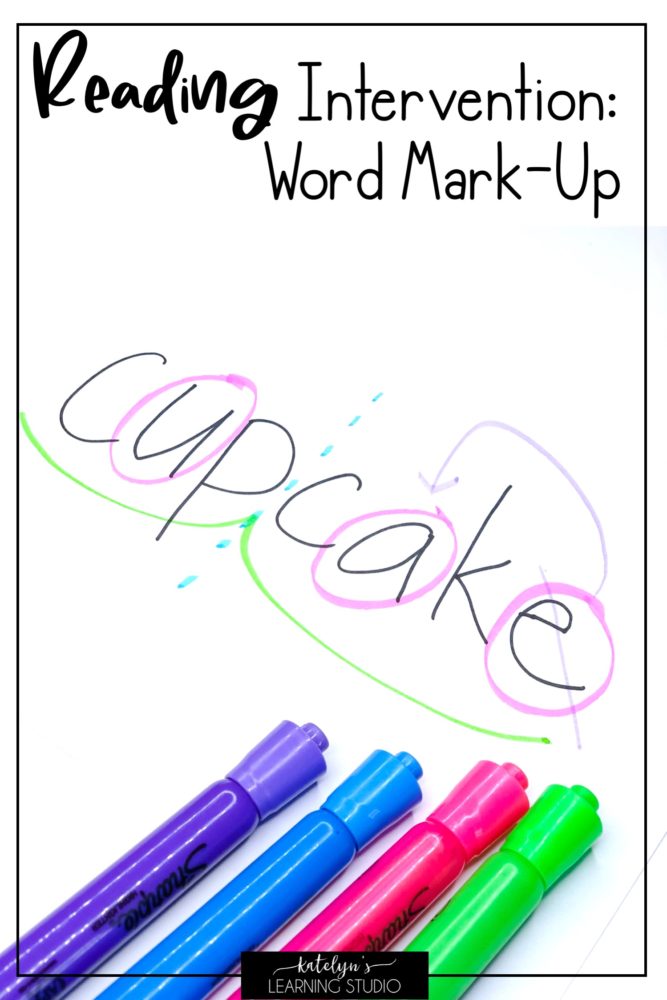
Mark-up patterns and syllables in words.
- Start with writing the word you are focusing on written out in front of you
- Then use other colors to draw attention to important parts
For example:
- Circle the vowels
- Underline the prefixes
- Cross out the silent letters
- Break apart chunks/syllables.
- You can also mark up sentences by circling the nouns/verbs, or breaking apart subject/predicate.
Amp up engagement by using whiteboards, or better yet, write directly on the desk or table with dry-erase markers! They wipe off pretty easily with a tissue or a baby wipe.
8. Visual Cues
- Hang posters up on the wall.
- Print out little cards to put on a binder ring to use as a personal visual cue booklet for students to keep at their desks.
- Name tags with references are also a great way to help visual learners.
- When I taught the alphabet, I used pictures of words that went with each sound that the letter made EVERY day.
Something to note with visual cues and posters is that just plain words are not always the most effective. The more visual aspects (like pictures, colors, arrows, graphic organizers, etc.) the better! You can use fancy sight word flash cards like these, or even just simple flashcards like these
.
9. Videos/Computer Games
Videos and games are super engaging reading intervention activities. They often provide great visuals, PLUS catchy tunes and repeated audio cues (which are also great for auditory learners!). There are so many great resources out there. Some of my favorite FREE sites are:
10. Finger Pointers
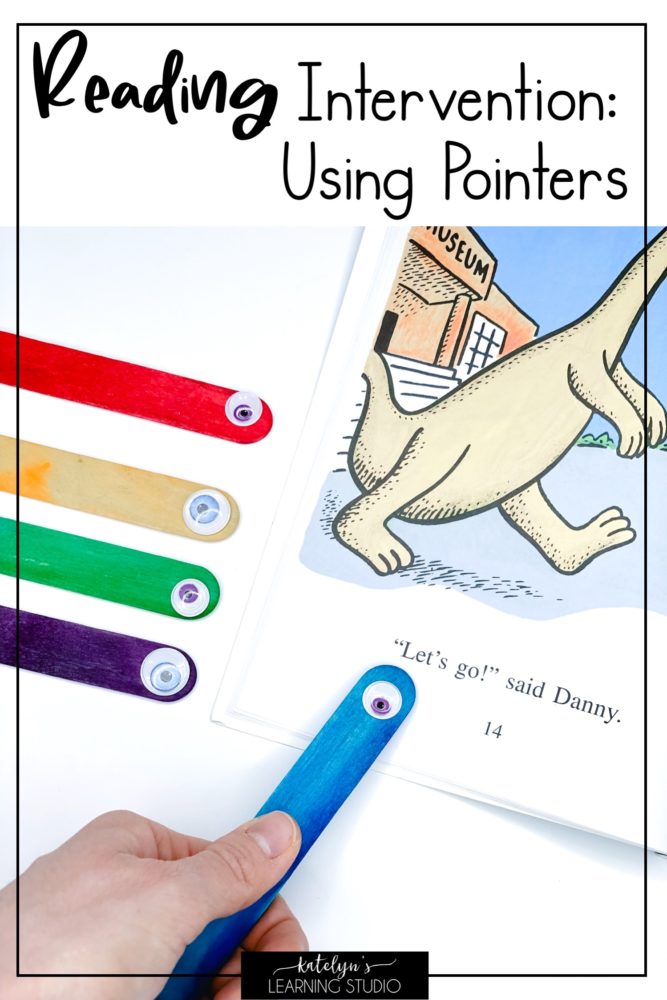
When working on fluency in your reading interventions, use fun pointer sticks.
A big page full of words can be overwhelming for our struggling readers. It helps to narrow their focus to just one letter or word at a time.
An easy way to do this is to use a finger pointer or pointing stick.
- Have students use the pointer to track along the word or page as they sound out words and read sentences.
- Keep fun reading pointers in your basket of reading intervention activities at your guided reading table.
The Dollar Store has little drink-stirring sticks, fun rings, fairy wands, or even witch fingers (depending on the season). Sometimes you can get lucky with the Target Dollar Spot too. Anything that is “stick-like” to point with, or that goes on your finger will work! Here are some fun ideas from amazon!
11. Writing and Spelling

Writing and spelling can be powerful reading intervention activities.
Writing as Reading Intervention:
- Have students keep a notebook for Guided Reading warm-ups.
- Give a focus word for the day, and as a group, spell the word out loud as you write each letter.
- Repeat at least three times.
- As a challenge, try covering up the original word they wrote and do the next 2 from memory!
- Each day add a new word, practicing all of the other words for the week as well.
You’ll be amazed at how easily the students will be able to read the words at the end of the week (even though you just practiced writing and spelling them)!
12. Drawing
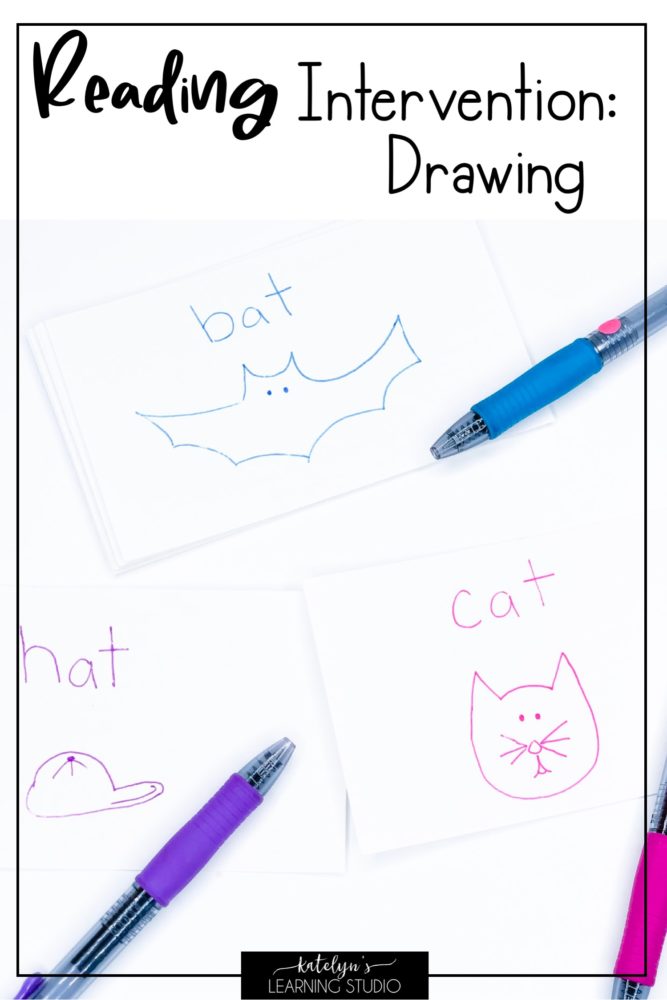
Use drawing to help students make connections.

Reading intervention binders with tons of activities to use with struggling readers.
Reading Intervention Activities for Auditory Learners:

Reading intervention activities you can use to help your struggling readers who are auditory learners.
13. Music
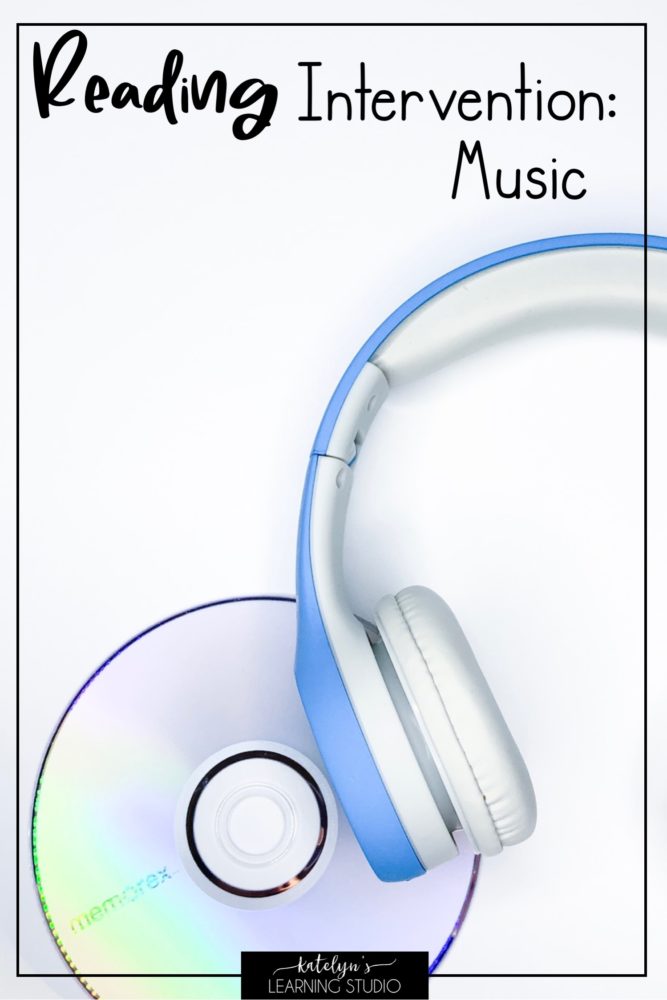
Music can be a fun and effective reading intervention.
Use music as a super fun and effective reading intervention activity. You can get fancy and choose a popular song and re-write the lyrics to it to teach the concept, or you can use some classic ones that are pretty easy to change the words to. Below are some easy song ideas. You can also add actions to the songs and hit kinesthetic learning as well!
- BINGO- To help spell any 5 letter word
- Row, Row, Row Your Boat- “A, a, a says /a/; a says /a/ /a/ /a/; a, a, a, a; letter a says /a/” or with any 3 letter word “a n d spells and; a n d spells and” etc.
- Mary Had a Little Lamb- “Letter a says /a/ /a/ /a/” or “a and i say /A/ /A/ /A/”
14. Rhymes
Rhymes are another way to help cue students’ memories for vocabulary words, spelling words, or key concepts. Come up with a rhyming (bonus for silly!) phrase students can memorize and think whenever they come across a certain skill. For example:
- “I before e, except after c.”
- “When two vowels go a’walking, the first one does the talking.”
- “Silent e plays a game, makes the vowel say it’s name.”
Also along the lines of rhyming, reading poetry can be very satisfying for auditory learners. Hearing the rhymes at the ends of lines makes sense for them and gives them a cue for reading. I love using these CVC word decodable poems and blends decodable poems.
15. Rhythm

Use rhythms in your reading interventions to help auditory learners.
Rhythm provides great listening cues as well as repetition and tactile/kinesthetic input. Use a patting, clapping, or snapping pattern. Say a rhythmic cue while doing the pattern, and have the students repeat it back to you. Examples of rhythmic reading intervention activities you can use are:
- Letter Names and Sounds (while reading an ABC chart)
- Pattern –> pat-pat clap-clap
- Teacher: pat-pat “a” clap-clap “/a/”
- Students: pat-pat “a” clap-clap “/a/”
- Teacher: pat-pat “b” clap-clap “/b/”
- Students: pat-pat “b” clap-clap “/b/”, etc.
- Progression –> move to just “pat-clap“
- Pattern –> pat-pat clap-clap
- Word Families (while reading a word family chart or list)
- Pattern –> pat-pat clap-clap
- Altogether: pat-pat “-at” clap-clap “-at”
- Altogether: pat-pat “what has” clap-clap “at?”
- Teacher: pat-pat “bat” Students: clap-clap “bat”
- Teacher: pat-pat “sat” Students: clap-clap “sat”, etc.
- Pattern –> pat-pat clap-clap
- Spelling Words:
- Pattern –> Make your own! Just use a new pattern for each group of words that have the same amount of letters.
- For each pat/clap/snap say a letter.
- Repeat pattern for each word that has that same amount of letters.
- Pattern –> Make your own! Just use a new pattern for each group of words that have the same amount of letters.
16. Teach a Friend
- Have two students partner up and take turns being the “teacher” to explain a concept.
- Then have them switch.
Reading Intervention Activities for Kinesthetic Learners:

Reading intervention activities that are great for kinesthetic learners.
17. Brain Dance
Believe it or not, you can use dance in your reading intervention activities! I learned this in my dance integration class in college, and it is AMAZING!! It was developed by Anne Green Gilbert and it helps students focus, feel refreshed, and calm down. This is perfect for a brain-break or a warm-up. It gets students moving and blood flowing so they have the energy to think, but it also stimulates parts of the brain in a way that helps students focus better.
Watch this video to see how to do it. Put it to some “Piano Guys” music, and it is magical!! 😍
18. Stepping on Letters/Words

Stepping on Words is a fun reading intervention activity that encourages movement.
- Write one letter, word, or sight word on a piece of paper and lay them out in a line.
- Students read the letter or word as they step (or jump) on it.
- If you are working on sentence reading, lay words out to make a sentence.
- If you are outside, you can use chalk and write the words in hopscotch squares and play hopscotch with them!
19. Actions
I am huge on actions in my reading intervention activities! Actions can help students memorize almost anything. You can have actions already made up, but I have found that they are more memorable if the students help you come up with them.
- Make an action for each letter of the alphabet that goes with the sound it makes.
- Ex: hands together in a “slither” motion for S (snake), arms outstretched in a clapping motion for A (alligator), etc.
- Make an action for each of your spelling words or sight words.
- Focus on the vowels, they are crucial for learning to read! Make an action for the short and long sound for each vowel.
- Ex: For short “e” cup your hand by your ear like you are old and can’t hear (“eh?”) and for long “e” show your teeth and move your hand like you are brushing your teeth (“eeee”).
20. Board Games

Use board games as a reading intervention activity to get students engaged and involved.
Reading intervention activities that involve games are especially motivating for your competitive kiddos! They get hands on opportunities by picking up and moving a game piece, and the game gives them context and motivation.
- Make a simple board game by drawing squares in a path, with a “Start” and “Finish” square.
- On each square in between write a spelling word, spelling pattern, sight word, vocabulary word, etc.
- Choose a couple of squares to be fun squares like “move forward 2 spaces” or “loose a turn”.
- Let students roll a die to move their game pieces, and read/define whatever word they land on.
- Here are some fun already-made St. Patrick’s Day phonics board games that make great reading intervention activities!
- Reading Intervention Binders (each one has a huge game section as a review!)
- Vowel Teams St. Patrick’s Day Activities
- CVC St. Patrick’s Day Activities
- Silent e St. Patrick’s Day Activities
- Word Endings St. Patrick’s Day Activities
21. Stretching Out Words

Slinkies and Rubber bands are great manipulatives to use in your reading intervention activities.
- Hold the slinkie in two hands
- With each sound you say, stretch the slinkie a little more
- Then bring the two ends of the slinkie back together as you say the whole word.
22. Toy Cars

For a fun reading intervention activity, use toy cars to drive out the sounds in words.
Toy cars in your reading intervention activities? This is instant engagement!
- Have words written with the letters spaced out.
- Start out by stopping at each letter as you say the sounds.
- Then slowly “drive” the car under each letter as you say the sound.
- Finally, drive the car quickly under the word as you say the whole word.
This helps transition from broken, segmented sounding out into the smooth sounding out that helps students learn to say the whole word.
23. Tap Lights
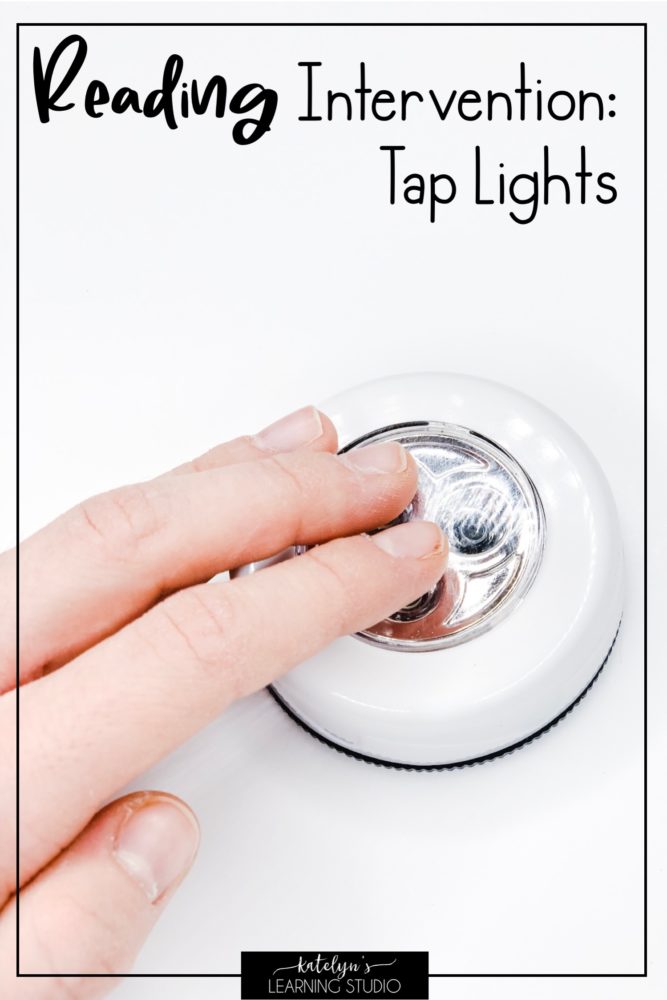
Tap lights are a fun tool students can interact with.
Having buttons to press and interact with is another good way to reach kinesthetic learners. You can buy tap lights from the dollar store for pretty cheap and stick them in your basket of reading intervention activities. These are great for hands-on phonemic awareness practice too. For more strategies for phonemic awareness, read out this blog post!
- Use them to practice sounding out words.
- Put a light under each letter of a word.
- Have students tap the lights as they sound the word out.
- Use them for segmenting words.
- The teacher says a word.
- The student taps a light for each sound in the word as they say it.
- For example… Teacher: “cat” Student: tap “/c/” tap “/a/” tap “/t/”
24. Sign Language Spelling
Here are some additional blog posts you might find helpful!
- Regardless of the type of learner your student is, all students need lots and lots of exposure to reading and good books. Here are 3 steps from 4 Kinder Teachers that will help you create meaningful read aloud experiences.
- Now that you have all these ideas for reading intervention activities to use with your students, check out this blog post with 6 tips to make your reading interventions actually work!
- Suzy from Grade School with Suzy also has some great tips for helping struggling readers here.
- If your students are struggling to find motivation to read, I also love these strategies for motivating students to read, from Teaching with Kaylee B. She has so many great ideas!
- I know many teachers also worry about the summer slide for their struggling readers. This post from Anna Kelly’s Creations gives some summer reading activity ideas to help keep your kiddos reading through their break!
-

Here are 6 tips for how to help struggling readers and make your reading interventions actually work.
